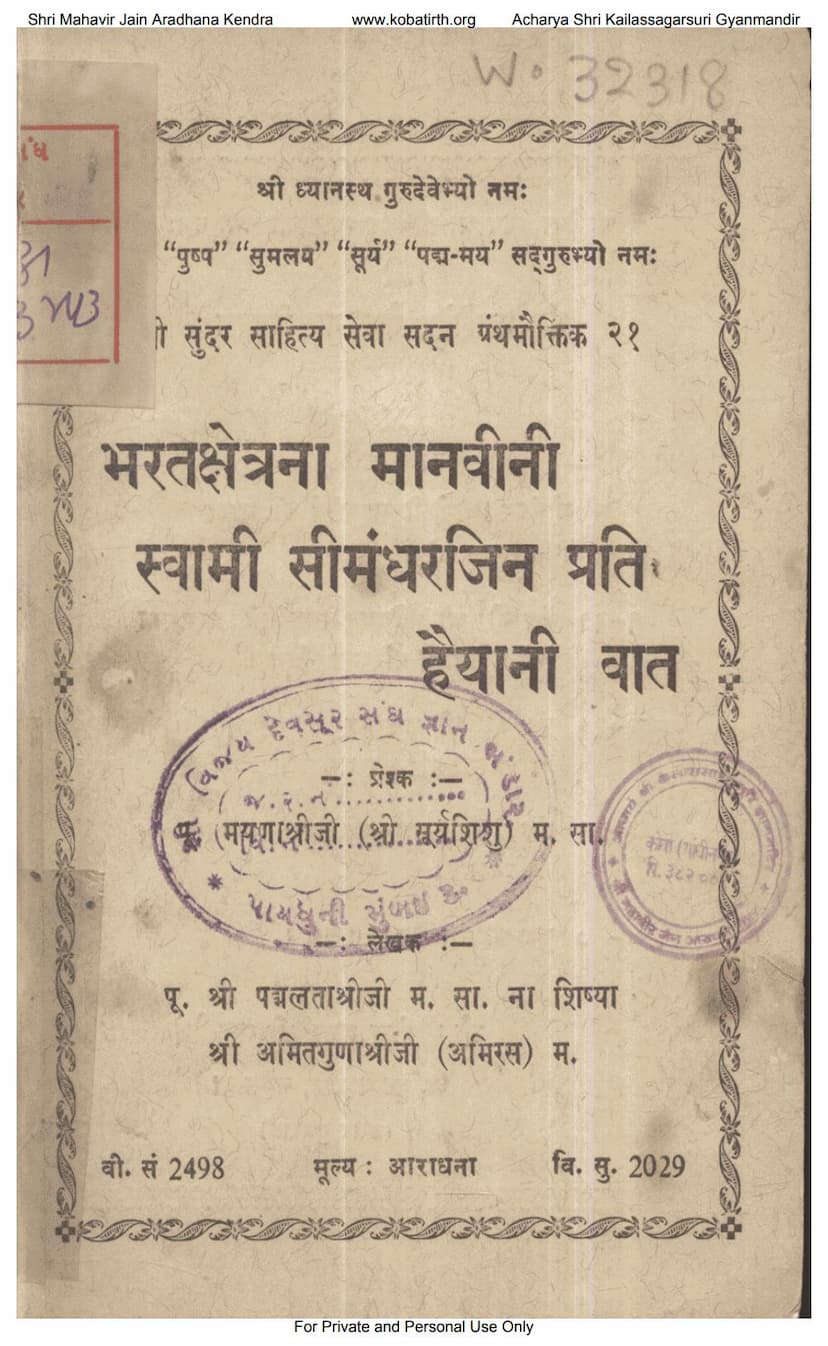Bharat Kshetrana Manvini Simandhar Jin Prati Haiyani Vat
Added to library: September 1, 2025

Summary
This document is the Gujarati book "Bharat Kshetrana Manvini Simandhar Jin Prati Haiyani Vat" (The Talk of Bharat Kshetra's Humans Towards Lord Simandhar Jin), authored by Amitgunashreeji and published by Sundar Sahitya Seva Sadan. It is part of a collection from the Shri Mahavir Jain Aradhana Kendra.
Here's a comprehensive summary of its content:
Core Theme:
The book is a devotional and philosophical exploration centered around Lord Simandhar Swami, one of the currently living Tirthankaras in the Mahavideh Kshetra. It expresses a deep longing and yearning from the inhabitants of Bharat Kshetra (our continent) to have darshan (vision) of Lord Simandhar Swami. The author conveys the profound spiritual longing and emotional connection of the devotee, particularly highlighting the limitations imposed by geographical distance and the current era.
Key Sections and Content:
- Introduction and Dedication: The book begins with salutations to various Jain Acharyas and spiritual leaders, indicating its lineage and respect for tradition. It also acknowledges the inspiration and blessings received from Acharya Dev Shrimat Padmasagarsurishwarji Maharaj Saheb.
- The Yearning for Lord Simandhar Swami (Page 8-16): The initial chapters articulate the deep desire of the soul in Bharat Kshetra to connect with Lord Simandhar Swami. The author uses evocative language to describe the emotional state of a devotee who longs for the spiritual presence of the Lord. There's a sense of separation and a fervent prayer for a spiritual connection despite the physical distance.
- Nature's Role and Divine Intervention (Page 25-28): The text delves into the concept that when the world is filled with violence, greed, and disharmony, nature, in its compassion, brings forth a Tirthankara or a divine messenger. This section draws parallels between natural phenomena and divine occurrences, suggesting that the advent of a Tirthankara is a response to the world's needs for peace and enlightenment.
- The Longing for the Past and the Present State (Page 29-31): The author reflects on the era of Tirthankaras, lamenting the absence of their direct presence in Bharat Kshetra in the current age. There's a search for truth and guidance in the face of worldly confusion and the difficulty of distinguishing right from wrong. The Jain Agamas (scriptures) are presented as a guiding light in this current state of spiritual darkness.
- The Path to Darshan and Spiritual Connection (Page 32-34): The book discusses the immense spiritual merit required to overcome the physical and metaphorical distances to reach Mahavideh Kshetra. It emphasizes that even if physical proximity is not possible, a deep inner devotion, prayer, and contemplation of Lord Simandhar Swami can lead to a spiritual experience of darshan.
- Description of Pushkalavati City and King Shreyans (Page 35-47): This extensive section provides a vivid description of Pushkalavati Vijay in the East Mahavideh Kshetra, focusing on the city's beauty, prosperity, and its virtuous king, Shreyans. It details the exemplary qualities of King Shreyans, his dedication to dharma, and his charitable nature. The narrative then beautifully portrays the conception and birth of a great soul, likely referring to Lord Simandhar Swami himself, highlighting the auspicious events and divine manifestations that accompanied it.
- The Birth of Lord Simandhar Swami (Page 47-54): This part of the book elaborates on the birth of Lord Simandhar Swami. It describes the celestial celebrations, the divine rituals performed by gods and goddesses, and the auspicious signs that accompanied his arrival. The narrative emphasizes the purity and divine nature of his birth, setting the stage for his future spiritual mission.
- The Path of Renunciation and Spiritual Practice (Page 54-58): The book then chronicles Lord Simandhar Swami's life, including his attainment of Keval Gyan (omniscience), his preaching, and the establishment of the four-fold Jain community (monks, nuns, laymen, and laywomen). It highlights his compassionate teachings, the miracles associated with him, and his ultimate liberation (Nirvana).
- Devotional Practices and Prayers (Page 59-76): A significant portion of the book is dedicated to various devotional practices and prayers (stavan, doha, chaitya-vandana) related to Lord Simandhar Swami. It includes instructions on how to perform Japa (chanting) of his name, the benefits of such practices, and the proper rituals for establishing sacred objects like a Kalash (pot) and a lamp. The text also provides specific mantras for purification and worship.
- The 'Five Kalyanakas' (Page 93): The document concludes with a list of the five auspicious events in the life of Lord Simandhar Swami: Chyavan Kalyanaka (descent into the womb), Janma Kalyanaka (birth), Diksha Kalyanaka (renunciation), Keval Gyan Kalyanaka (attainment of omniscience), and Nirvana Kalyanaka (liberation).
Overall Tone and Message:
The book is filled with deep devotion, reverence, and a longing for spiritual connection. It aims to inspire readers to cultivate devotion towards Lord Simandhar Swami, understand his teachings, and strive for spiritual upliftment, even in the absence of his physical presence in Bharat Kshetra. The author, Amitgunashreeji, through her profound spiritual insights and poetic expression, guides the reader on a journey of faith and devotion, emphasizing that true connection transcends physical boundaries. The publication is a testament to the enduring faith and spiritual aspirations of the Jain community.